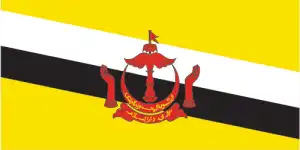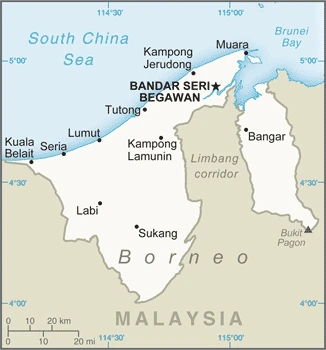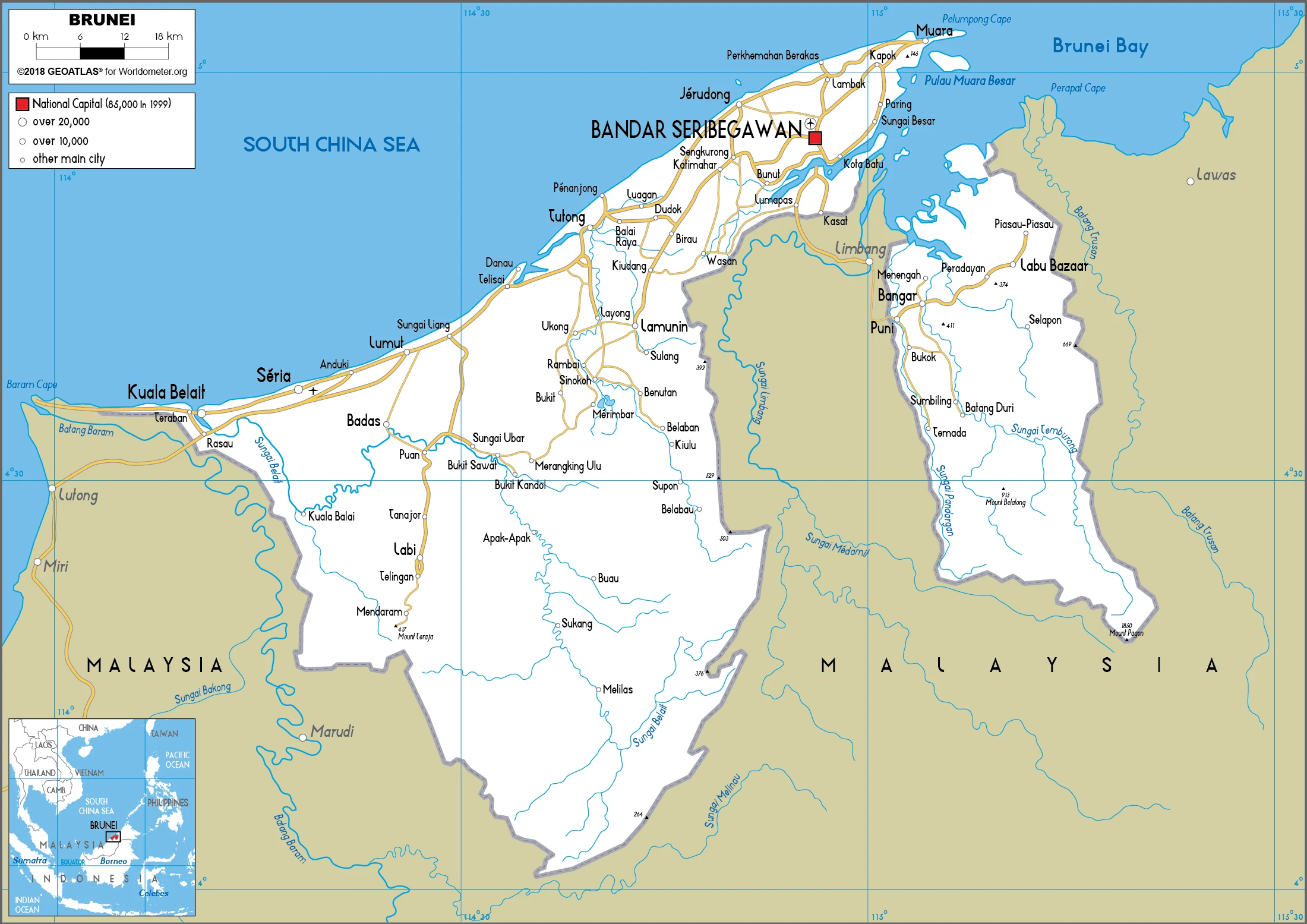Brunei Google Maps is a site/tool that offers a wide range of map views (topographic, satellite, street view) and navigation options, with little effort on your part, yet efficiently. If you need to plan a trip to a new place like Brunei, Google maps are available on desktop, mobile, or tablet. This Google maps and information page is dedicated to Brunei, Southeast Asia (19 countries), showing its location, country facts, details about its capital city Bandar Seri Begawan, bordering countries like Malaysia, and plenty of other information which may be interesting when you visit this Southeastern Asian state.
Quick links: Google Maps Brunei, Bandar Seri Begawan Google maps, Driving Directions Brunei, Printable Road Map.

About Brunei in a nutshell
- The sultan spent US$350 million building the worlds largest palace at Bandar Seri Begawan.
- Conventional short form of the name: Brunei
- The conventional long form of the name: Brunei Darussalam
- Local long form: Negara Brunei Darussalam
- Local short form: Brunei
- Former name(s): N/A
- Etymology: derivation of the name is unclear; according to legend, MUHAMMAD SHAH, who would become the first sultan of Brunei, upon discovering what would become Brunei exclaimed Baru nah, which roughly translates as there or thats it.
- The legal system in Brunei: mixed legal system based on English common law and Islamic law.
- Climate: Tropical. Six-month rainy season with very high humidity. Malays benefit from positive
- The national symbols are royal parasol; national colors: yellow, white, black.
- Internet TLD: .bn
Background
The Sultanate of Brunei’s influence peaked between the 15th and 17th centuries when its control extended over coastal areas of northwest Borneo and the southern Philippines. Brunei subsequently entered a period of decline brought on by internal strife over royal succession, colonial expansion of European powers, and piracy. In 1888, Brunei became a British protectorate. Independence was achieved in 1984. The same family has ruled Brunei for over six centuries. Brunei benefits from extensive petroleum and natural gas fields, the source of one of the highest per capita GDPs in the world. In 2017, Brunei celebrated the 50th anniversary of Sultan Hassanal Bolkiah’s accession to the throne.
Geography
Mostly dense lowland rainforest and mangrove swamps, with some mountains in the southeast.

Lying on the northern coast of the island of Borneo, Brunei is surrounded and divided in two by the Malaysian state of Sarawak. It has been independent since 1984.
This state is located in Southeastern Asia, along the northern coast of the island of Borneo, bordering the South China Sea and Malaysia, under the coordinates of 4 30 N, 114 40 E, covering an area of 5,765 sq km with a coastline of 161 km. Brunei is Slightly smaller than Delaware.
Brunei has 266 km of land boundaries and borders with (1 nation): Malaysia 266 km.
Flat coastal plain rises to mountains in east, hilly lowland in the west, with Bukit Pagon 1,850 m as the highest point of Brunei, while the South China Sea 0 m as the lowest point, causing a mean elevation at 478 m throughout the country. With a total of 5,765 sq km, Brunei has 5,265 sq km of land and 500 sq km water surface area.
close to vital sea lanes through the South China Sea linking Indian and Pacific Oceans; two parts physically separated by Malaysia; the eastern part, the Temburong district, is an exclave and is almost an enclave within Malaysia
The climate in Brunei is as follows: Tropical, hot, humid, rainy.
When you visit Brunei, the natural hazards shall be considered: Typhoons, earthquakes, and severe flooding are rare.
The following major health-threatening issues shall be considered when visiting Brunei: none.
Current environmental issues affecting the Bruneian people: no major environmental problems, but air pollution control is becoming a concern; seasonal transboundary haze from forest fires in Indonesia.
Google Maps Brunei
The capital and other divisions
Capital city: Bandar Seri Begawan found under the coordinates 4 53 N, 114 56 E, applying the time zone UTC+8 (13 hours ahead of Washington, DC, during Standard Time), using the following daylight saving time: none.
Bandar Seri Begawan is the capital of Brunei, an archipelago nation consisting of over 100 small islands. The country has been a part of China since the 15th century, making it one of the oldest inhabited places in Asia. Located on the northeast coast of Borneo, Bandar Seri Begawan was founded by Sultan Omar Ali Saifuddin I in 1785 as a seaside fortress during his struggles with pirates’ attacks. The city flourished and developed.
Brunei became independent on 1 January 1984 (from the UK), and its national holiday is National Day, 23 February (1984).
Administrative divisions: 4 districts (daerah-daerah, singular – daerah); Belait, Brunei dan Muara, Temburong, Tutong.
People and society
Malays benefit from positive discrimination. Many in the Chinese community are stateless. Since a failed rebellion in 1962, Brunei has been ruled by the sultan’s decree. In 1990, the “Malay Muslim Monarchy” was introduced, promoting Islamic values as a state ideology. Women, less restricted than in some Muslim states, usually wear headscarves but not the veil.
The population in Brunei is 471,103 (July 2021 estimate). Note: immigrants make up approximately 26% of the total population, according to UN data (2019), with an average of 1.48% (2021 estimate) change. That means Brunei is the No. 173 in the world’s populated rank list. With an average of 31.1 years median age (30.5 years for males and 30.5 years for women), Brunei ranks No. 116 on the globe’s median age rank list.
The people living in this country are the Bruneian(s) (noun) or Bruneian (adjective) and belong mainly to the following ethnic groups: Malay 65.7%, Chinese 10.3%, other 24% (2019 estimate).
They speak Malay (Bahasa Melayu) (official language), English, Chinese dialects languages and practice the following religions: Muslim (official) 78.8%, Christian 8.7%, Buddhist 7.8%, other (includes indigenous beliefs) 4.7% (2011 estimate).
We can conclude the following about the population in Brunei: N/A In Brunei, we are talking about 78.6% (2021) of the total population is living in cities, and most of them reside in the following municipalities: 241,000 Bandar Seri Begawan (capital city) (2011) Note: The Boundaries Of The Capital City Were Expanded In 2007, Greatly Increasing The City Area; The Population Of The Capital Increased Tenfold.
Industry
Oil and natural gas production has brought one of the worlds highest living standards. Massive overseas investments. Major consumer of high-tech hi-fi, video equipment, and Western designer clothes.
Brunei is an energy-rich sultanate on the northern coast of Borneo in Southeast Asia. Brunei boasts a well-educated, predominantly English-speaking population; excellent infrastructure; and a stable government intent on attracting foreign investment. Crude oil and natural gas production account for approximately 65% of GDP and 95% of exports, with Japan as the primary export market.
Per capita GDP is among the highest globally, and substantial income from overseas investment supplements income from domestic hydrocarbon production. Bruneian citizens pay no personal income taxes, and the Government provides free medical services and free education through the university level.
The Bruneian Government wants to diversify its economy from hydrocarbon exports to other industries such as information and communications technology and halal manufacturing, permissible under Islamic law. Brunei’s trade increased in 2016 and 2017, following its regional economic integration in the ASEAN Economic Community and the expected ratification of the Trans-Pacific Partnership trade agreement.
Brunei is rich in the following natural resources: Petroleum, natural gas, timber.
The main industrial sectors are petroleum, petroleum refining, liquefied natural gas, construction, agriculture, aquaculture, transportation.
The country’s export sectors are particularly strong in natural gas, crude petroleum, refined petroleum, industrial alcohols, industrial hydrocarbons (2019), partnering with these nations: Japan 34%, Australia 12%, Singapore 10%, India 8%, Malaysia 8%, Thailand 7%, China 6%, South Korea 5% (2019). The export trade resulted in $7.83 billion. Note: Data are in current year dollars (2019 estimate). In a global rank of the export, values resulted in Brunei’s position of 106.
Land use in Brunei: 71.8% (2018 estimate) forest, 25.7% (2018 estimate) other.
The arable land area is 0.8% (2018 estimate), and the agricultural land is 2.5% (2018 estimate). Land use for permanent crops 1.1% (2018 estimate), permanent pasture 0.6% (2018 estimate). The sum of the area of the irrigated land is 10 sq km (2012).
The main agro-industrial products of Brunei are poultry, eggs, fruit, cassava, bananas, legumes, cucumbers, rice, pineapples, beef.
The country typically needs to import: crude petroleum, refined petroleum, cars, tug boats, valves (2019), partnering with the following nations: Singapore 18%, China 14%, Malaysia 12%, Nigeria 5%, United Arab Emirates 5%, United States 5% (2019) in a sum value of $6.81 billion. Note: data are in current year dollars (2019 estimate) $5.68 billion. Note: data are in current year dollars (2018 estimate). This sum value on the global ranking list of imports resulted in Brunei 127.
Brunei Driving Directions
In this post, you learned about Brunei, Southeastern Asia, along the northern coast of the island of Borneo, bordering the South China Sea and Malaysia. We published some basic information about its capital Bandar Seri Begawan, and the Bruneian nation.
Are you interested in visiting Brunei and looking for driving directions? Click here to plan your route, or see a printable road map of Brunei below for an overview of the route network.
Printable map of Brunei
Did you know about Brunei?
It is the only sovereign state on the island of Borneo. Brunei is a small, oil-rich country located in Southeast Asia. Though it is a small country, Brunei has developed very well. That’s because the Government has been investing heavily in education and infrastructure for years. They have used their petroleum profits to invest in technology and education systems. The result was incredible economic growth and development over the past few decades.
After virtually visiting Brunei, you may also be interested in the neighboring country: Malaysia.
If you liked our Google map and Brunei information page,
please share it with others or save the link https://www.drivingdirections.net in your bookmarks.

